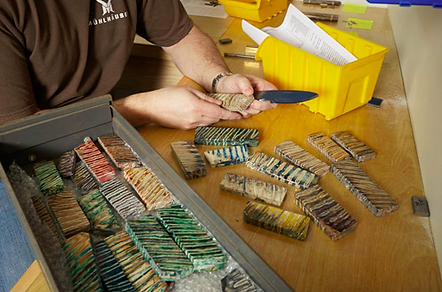How we make our handmade knives
Many knifemakers are secretive about their trade. This is understandable as it takes many years to learn how to make a knife from scratch. Every knifemaker has their own set of skills, and we all hope that we keep improving those skills, as well as our finished products as we progress. At M.G. Muhlhauser & Sohne, we want you to know how we will make your new custom knife. It takes considerable time, skill and resources to make your knife. Knowing how it is made makes the ownership experience that much more special!
Of course, we can't show you every single step along the way, but we hope the pictures and descriptions that follow help you better understand just a little bit of what goes into making M.G. Muhlhauser & Sohne distinctive knives. Just a quick note about the pictures that follow… we are using a few different knives which were in various stages of production at the time the pictures were taken. All were fixed blade hunting knives. We had the benefit of a very helpful photographer who followed us for the day. Due to the number of steps required to properly make a custom knife, a typical build takes place over the course of many days. It is therefore we used multiple knives to illustrate some of the steps involved.
Design and Materials Selection
The first step in building any knife is to choose some very important items. First, we select a model based on the desired use of the knife. We may use one of the dozen or more standard models we have, or make a completely new, one of a kind model for the customer.
Once we know the model, we will select the type of knife steel we will use. The most common steels we use include CPM154, 440C and stainless Damascus steels – but we stock many different types (or patterns in the case of Damascus). Each has their merits and unique characteristics. (learn more about the knife steel we use)
Next we determine what the handle might look like. Will it be wood, mammoth tooth, coral, ivory, bone, antler, or a man-made material? Again, there are lots of considerations. Some are heavier than others, some more durable. Either way, we stock lots of handle materials so there are many options when trying to find just the right one. (learn more about our knife handles).
For this knife, we are selecting a mammoth tooth knife scale for one of our Warthog model custom hunting knives. We try to match the handle to the blade to make sure the design flows well. This is very important – after all, the knife is designed to accompany its owner for decades, and then be passed to the next generation!
You'll notice a yellow bin in the background. The paper in it is a detailed specification sheet for the knife, which contains everything from the model, to the type and thickness of the steel used, handles, pins, sheath and other instructions or customer requests. The paperwork also contains a complete checklist of over 50 items, each of which is marked off by the knife maker, dated, and inspected. We believe that these checklists are just good business practice, and help to ensure that no items or requests go overlooked. You'll see these bins and spec sheets throughout the pictures in the process.
At this time we will also determine if there will be bolsters and pommels on the knife, and if so, what materials we will use for these components. We then determine how the handle will be attached. For example, if we will be pinning the knife scales to the tang, we have some choices such as pins to match the bolsters, or more decorative mosaic pins to add a little more flair to the knife.
Next - Profiling the Knife Blade >>>

Here I am selecting a set of mammoth tooth scales for the handle on a new handmade Muhlhauser hunting knife.
